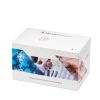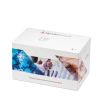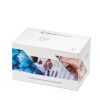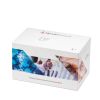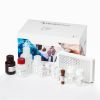FHR-2, Human, ELISA kit – 1 x 96 det. - HK3004-01
Catalog #
HK3004-01
825,00 €
Complement Factor H-Related Protein 2 (FHR-2) is a significant member of the complement regulatory protein family, with a molecular weight of around 29 kDa. Synthesized mainly in the liver, FHR-2 is also produced by immune cells like monocytes, macrophages, and dendritic cells. Sharing structural homology with Complement Factor H (CFH), FHR-2 plays a role in regulating the complement cascade, although its exact biological function remains somewhat elusive and subject to debate.
Research indicates that FHR-2 may inhibit the activity of the alternative pathway (AP) C3 convertase, which would theoretically prevent the formation of the membrane attack complex (MAC). Conversely, some studies suggest that FHR-2 might actually promote AP activation, highlighted by findings where a hybrid mutant protein comprising FHR-5 domains and full-length FHR-2 led to overactivation of the complement system.
FHR-2 has been linked to various diseases where abnormal complement activation is a contributing factor. Particularly, it is associated with atypical hemolytic uremic syndrome (aHUS) and age-related macular degeneration (AMD), where dysregulation in complement activation leads to detrimental tissue deposition. The involvement of FHR-2 in these pathologies, specifically in the alternative pathway, makes it a potential therapeutic target in managing diseases driven by complement dysregulation.
FHR-2 can be measured with our HK3004 assay, designed to precisely quantify this intriguing glycoprotein.
Research indicates that FHR-2 may inhibit the activity of the alternative pathway (AP) C3 convertase, which would theoretically prevent the formation of the membrane attack complex (MAC). Conversely, some studies suggest that FHR-2 might actually promote AP activation, highlighted by findings where a hybrid mutant protein comprising FHR-5 domains and full-length FHR-2 led to overactivation of the complement system.
FHR-2 has been linked to various diseases where abnormal complement activation is a contributing factor. Particularly, it is associated with atypical hemolytic uremic syndrome (aHUS) and age-related macular degeneration (AMD), where dysregulation in complement activation leads to detrimental tissue deposition. The involvement of FHR-2 in these pathologies, specifically in the alternative pathway, makes it a potential therapeutic target in managing diseases driven by complement dysregulation.
FHR-2 can be measured with our HK3004 assay, designed to precisely quantify this intriguing glycoprotein.
| Datasheet URL | https://www.hycultbiotech.com/wp-content/uploads/2024/04/HK3004-0324.pdf |
|---|---|
| Quantity | 1x96det. |
| Working volume | 100 µl/well |
| Species | human |
| Cross reactivity | Monkey - Yes, Mouse - No, Pig - No, Rat - No |
| Alias | Complement Factor H-related protein 2 |
| Principle | The human FHR-2 ELISA is a ready-to-use solid-phase enzyme-linked immunosorbent assay based on the sandwich principle with a working time of 1 hour and 15 minutes. The efficient format of a plate with twelve disposable 8-well strips allows free choice of batch size for the assay. Samples and standards are incubated in microtiter wells coated with antibodies recognizing human FHR-2. Peroxidase-conjugated antibody will bind to the captured FHR-2. Peroxidase-conjugate will react with the substrate, tetramethylbenzidine (TMB). The enzyme reaction is stopped by the addition of oxalic acid. The absorbance at 450 nm is measured with a spectrophotometer. A standard curve is obtained by plotting the absorbance (linear) versus the corresponding concentrations of the human FHR-2 standards (log). The human FHR-2 concentration of samples, which are run concurrently with the standards, can be determined from the standard curve. |
| Storage and stability | Product should be stored at 4 °C. Under recommended storage conditions, product is stable for at least six months. |
| Precautions | For research use only. Not for use in or on humans or animals or for diagnostics. It is the responsibility of the user to comply with all local/state and federal rules in the use of this product. Hycult Biotech is not responsible for any patent infringements that might result from the use or derivation of this product. |
| Disease | Autoimmunity, Infectious diseases, Nephrology, Tumor immunology |
| Principle: | The human FHR-2 ELISA is a ready-to-use solid-phase enzyme-linked immunosorbent assay based on the sandwich principle with a working time of 1 hour and 15 minutes. The efficient format of a plate with twelve disposable 8-well strips allows free choice of batch size for the assay. Samples and standards are incubated in microtiter wells coated with antibodies recognizing human FHR-2. Peroxidase-conjugated antibody will bind to the captured FHR-2. Peroxidase-conjugate will react with the substrate, tetramethylbenzidine (TMB). The enzyme reaction is stopped by the addition of oxalic acid. The absorbance at 450 nm is measured with a spectrophotometer. A standard curve is obtained by plotting the absorbance (linear) versus the corresponding concentrations of the human FHR-2 standards (log). The human FHR-2 concentration of samples, which are run concurrently with the standards, can be determined from the standard curve. |
|---|


